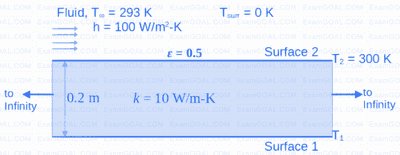Consider a solid slab (thermal conductivity, k = 10 W∙m-1∙K-1) with thickness 0.2 m and of infinite extent in the other two directions as shown in the figure. Surface 2, at 300 K, is exposed to a fluid flow at a free stream temperature (T∞) of 293 K, with a convective heat transfer coefficient (h) of 100 W∙m-2∙K-1. Surface 2 is opaque, diffuse and gray with an emissivity (ε) of 0.5 and exchanges heat by radiation with very large surroundings at 0 K. Radiative heat transfer inside the solid slab is neglected. The Stefan-Boltzmann constant is 5.67 × 10-8 W∙m-2∙K-4. The temperature T1 of Surface 1 of the slab, under steady-state conditions, is _________ K (round off to the nearest integer).

During open-heart surgery, a patient’s blood is cooled down to 25 °C from 37 °C using a concentric tube counter-flow heat exchanger. Water enters the heat exchanger at 4 °C and leaves at 18 °C. Blood flow rate during the surgery is 5 L/minute.
Use the following fluid properties :
$$ \begin{array}{|c|c|c|} \hline \text { Fluid } & \text { Density }\left(\mathrm{kg} / \mathrm{m}^3\right) & \text { Specific heat }(\mathrm{J} / \mathrm{kg}-\mathrm{K}) \\ \hline \text { Blood } & 1050 & 3740 \\ \hline \text { Water } & 1000 & 4200 \\ \hline \end{array} $$Effectiveness of the heat exchanger is _________ (round off to 2 decimal places).